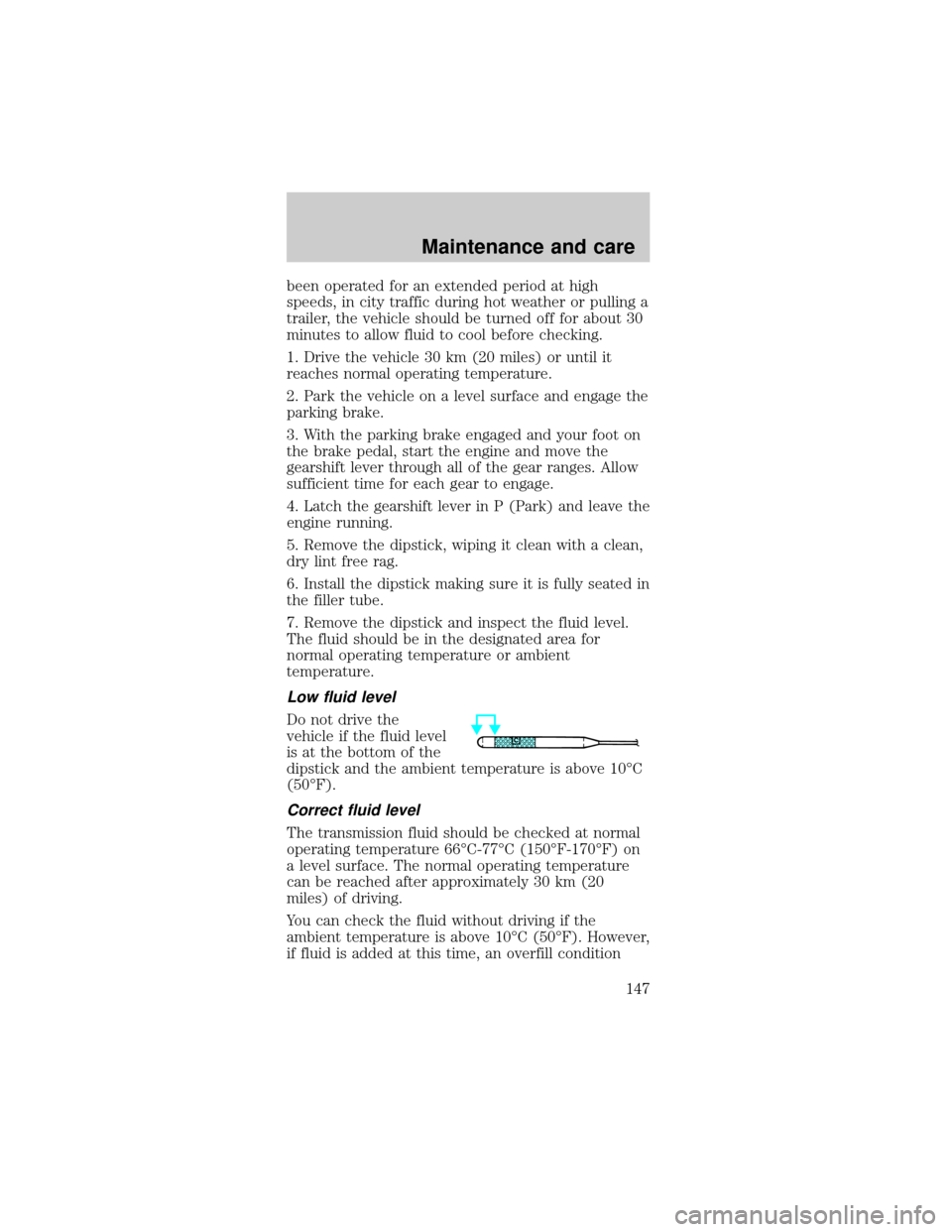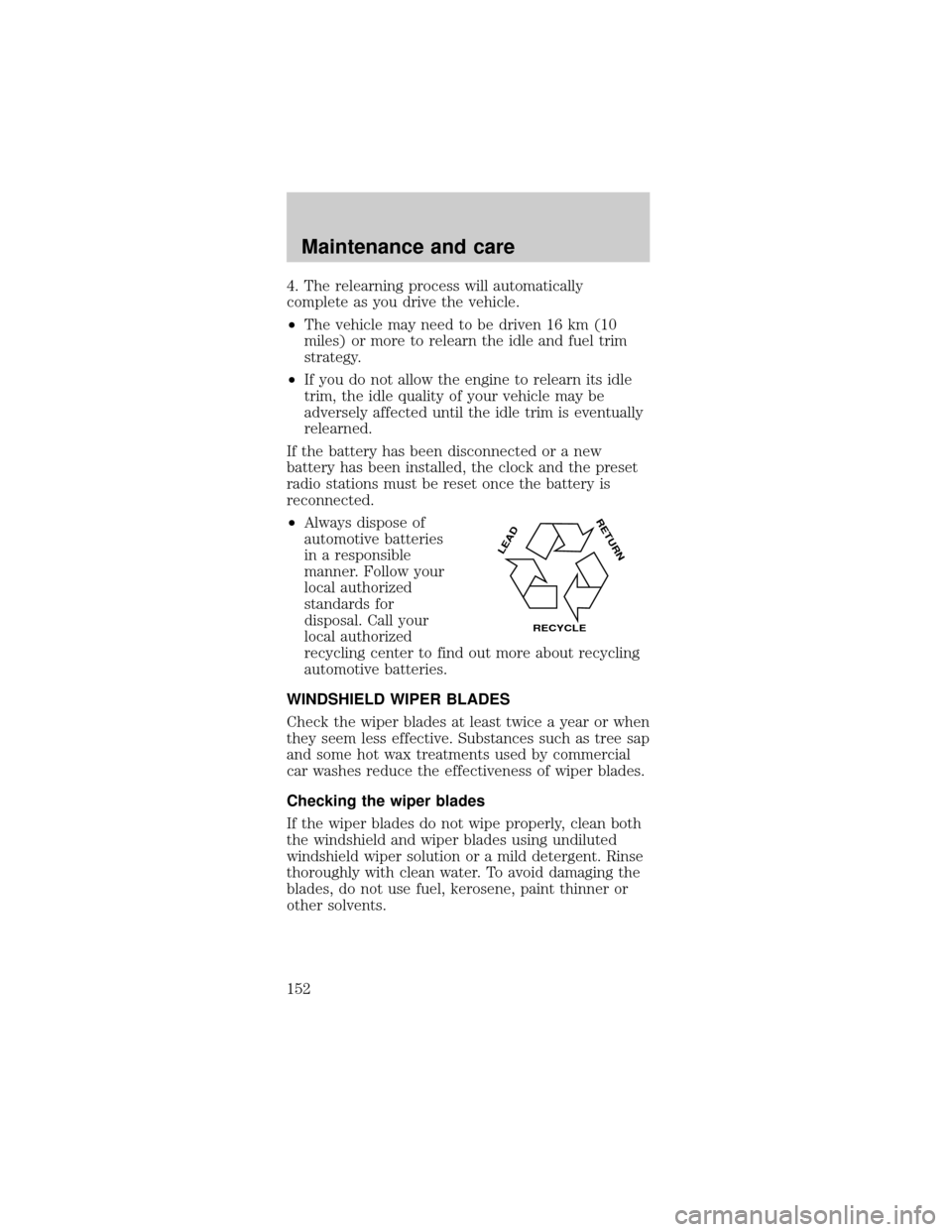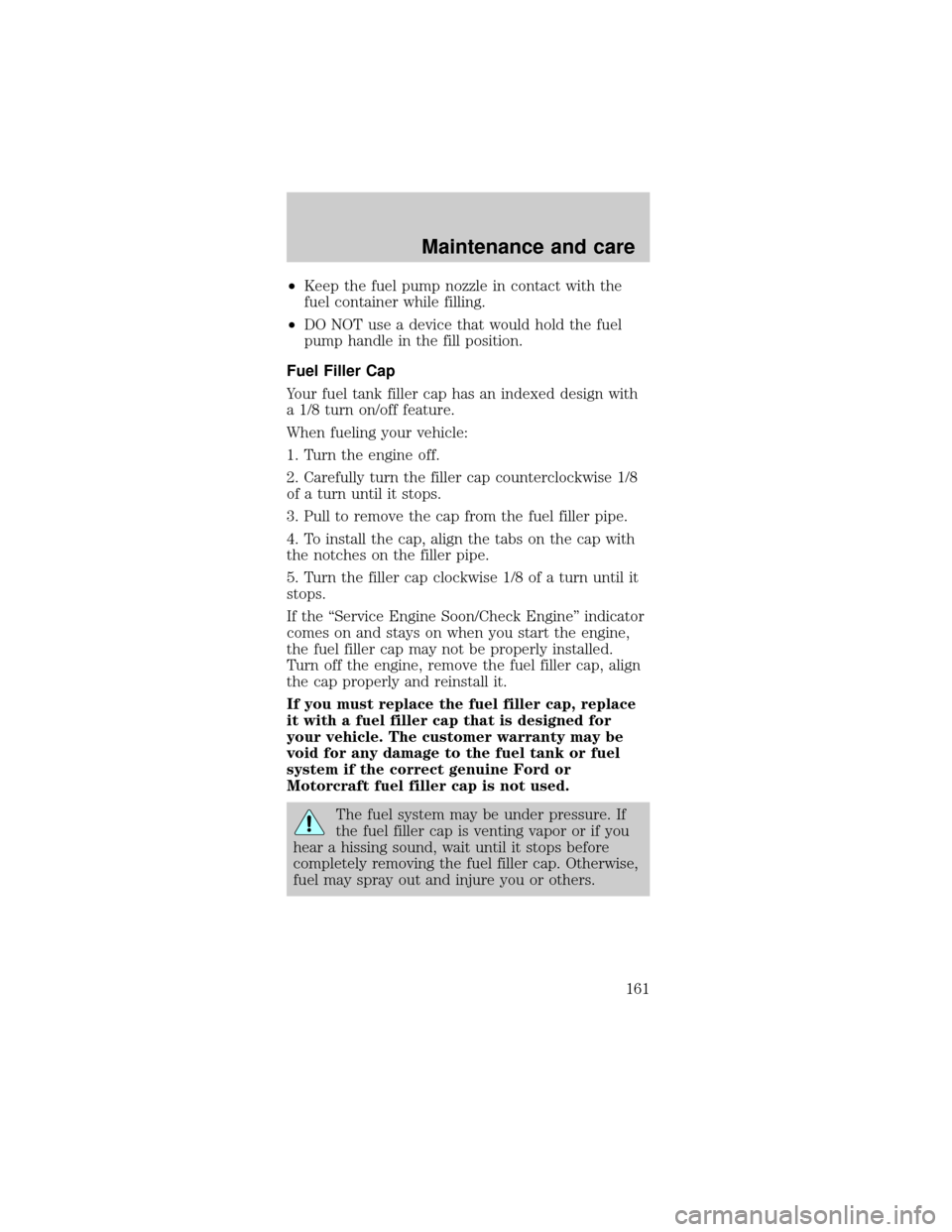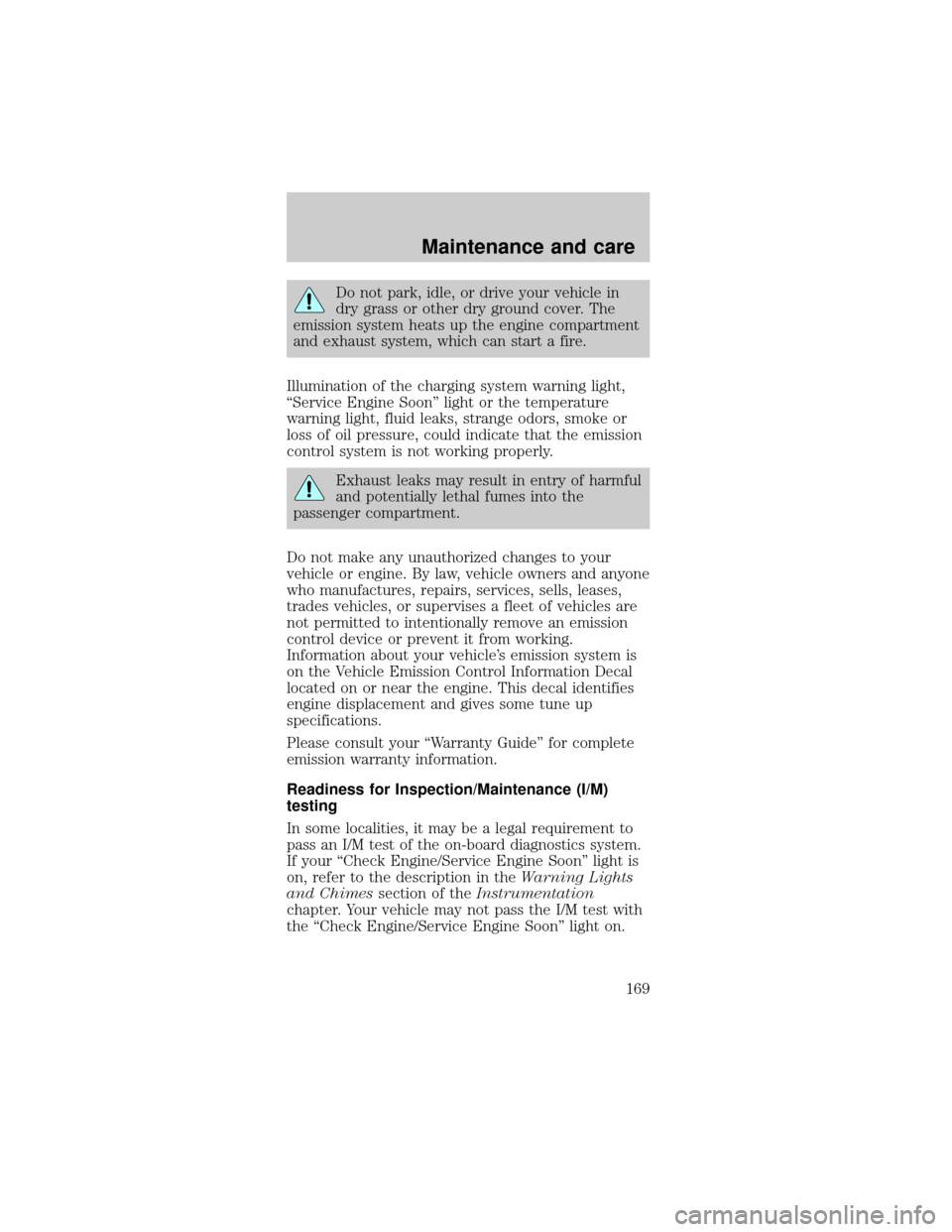check engine FORD MUSTANG 1999 4.G Owner's Manual
[x] Cancel search | Manufacturer: FORD, Model Year: 1999, Model line: MUSTANG, Model: FORD MUSTANG 1999 4.GPages: 216, PDF Size: 1.72 MB
Page 147 of 216

been operated for an extended period at high
speeds, in city traffic during hot weather or pulling a
trailer, the vehicle should be turned off for about 30
minutes to allow fluid to cool before checking.
1. Drive the vehicle 30 km (20 miles) or until it
reaches normal operating temperature.
2. Park the vehicle on a level surface and engage the
parking brake.
3. With the parking brake engaged and your foot on
the brake pedal, start the engine and move the
gearshift lever through all of the gear ranges. Allow
sufficient time for each gear to engage.
4. Latch the gearshift lever in P (Park) and leave the
engine running.
5. Remove the dipstick, wiping it clean with a clean,
dry lint free rag.
6. Install the dipstick making sure it is fully seated in
the filler tube.
7. Remove the dipstick and inspect the fluid level.
The fluid should be in the designated area for
normal operating temperature or ambient
temperature.
Low fluid level
Do not drive the
vehicle if the fluid level
is at the bottom of the
dipstick and the ambient temperature is above 10ÉC
(50ÉF).
Correct fluid level
The transmission fluid should be checked at normal
operating temperature 66ÉC-77ÉC (150ÉF-170ÉF) on
a level surface. The normal operating temperature
can be reached after approximately 30 km (20
miles) of driving.
You can check the fluid without driving if the
ambient temperature is above 10ÉC (50ÉF). However,
if fluid is added at this time, an overfill condition
Maintenance and care
147
Page 152 of 216

4. The relearning process will automatically
complete as you drive the vehicle.
²The vehicle may need to be driven 16 km (10
miles) or more to relearn the idle and fuel trim
strategy.
²If you do not allow the engine to relearn its idle
trim, the idle quality of your vehicle may be
adversely affected until the idle trim is eventually
relearned.
If the battery has been disconnected or a new
battery has been installed, the clock and the preset
radio stations must be reset once the battery is
reconnected.
²Always dispose of
automotive batteries
in a responsible
manner. Follow your
local authorized
standards for
disposal. Call your
local authorized
recycling center to find out more about recycling
automotive batteries.
WINDSHIELD WIPER BLADES
Check the wiper blades at least twice a year or when
they seem less effective. Substances such as tree sap
and some hot wax treatments used by commercial
car washes reduce the effectiveness of wiper blades.
Checking the wiper blades
If the wiper blades do not wipe properly, clean both
the windshield and wiper blades using undiluted
windshield wiper solution or a mild detergent. Rinse
thoroughly with clean water. To avoid damaging the
blades, do not use fuel, kerosene, paint thinner or
other solvents.
LEAD
RETURN
RECYCLE
Maintenance and care
152
Page 161 of 216

²Keep the fuel pump nozzle in contact with the
fuel container while filling.
²DO NOT use a device that would hold the fuel
pump handle in the fill position.
Fuel Filler Cap
Your fuel tank filler cap has an indexed design with
a 1/8 turn on/off feature.
When fueling your vehicle:
1. Turn the engine off.
2. Carefully turn the filler cap counterclockwise 1/8
of a turn until it stops.
3. Pull to remove the cap from the fuel filler pipe.
4. To install the cap, align the tabs on the cap with
the notches on the filler pipe.
5. Turn the filler cap clockwise 1/8 of a turn until it
stops.
If the ªService Engine Soon/Check Engineº indicator
comes on and stays on when you start the engine,
the fuel filler cap may not be properly installed.
Turn off the engine, remove the fuel filler cap, align
the cap properly and reinstall it.
If you must replace the fuel filler cap, replace
it with a fuel filler cap that is designed for
your vehicle. The customer warranty may be
void for any damage to the fuel tank or fuel
system if the correct genuine Ford or
Motorcraft fuel filler cap is not used.
The fuel system may be under pressure. If
the fuel filler cap is venting vapor or if you
hear a hissing sound, wait until it stops before
completely removing the fuel filler cap. Otherwise,
fuel may spray out and injure you or others.
Maintenance and care
161
Page 167 of 216

²Combine errands and minimize stop-and-go
driving.
Maintenance
²Keep tires properly inflated and use only
recommended size.
²Operating a vehicle with the wheels out of
alignment will reduce fuel economy.
²Use recommended engine oil. Refer toLubricant
Specifications.
²Perform all regularly scheduled maintenance
items. Follow the recommended maintenance
schedule and owner maintenance checks found in
your vehicle Scheduled Maintenance Guide.
Conditions
²Heavily loading a vehicle or towing a trailer may
reduce fuel economy at any speed.
²Carrying unnecessary weight may reduce fuel
economy (approximately 2 km/h [1 mpg] is lost
for every 180 kg [400 lb] of weight carried).
²Adding certain accessories to your vehicle (for
example bug deflectors, rollover/light bars,
running boards, ski/luggage racks) may reduce
fuel economy.
²Using fuel blended with alcohol may lower fuel
economy.
²Fuel economy may decrease with lower
temperatures during the first 12±16 km (8±10
miles) of driving.
²Driving on flat terrain offers improved fuel
economy as compared to driving on hilly terrain.
²Transmissions give their best fuel economy when
operated in the top cruise gear and with steady
pressure on the gas pedal.
²Close windows for high speed driving.
Maintenance and care
167
Page 169 of 216

Do not park, idle, or drive your vehicle in
dry grass or other dry ground cover. The
emission system heats up the engine compartment
and exhaust system, which can start a fire.
Illumination of the charging system warning light,
ªService Engine Soonº light or the temperature
warning light, fluid leaks, strange odors, smoke or
loss of oil pressure, could indicate that the emission
control system is not working properly.
Exhaust leaks may result in entry of harmful
and potentially lethal fumes into the
passenger compartment.
Do not make any unauthorized changes to your
vehicle or engine. By law, vehicle owners and anyone
who manufactures, repairs, services, sells, leases,
trades vehicles, or supervises a fleet of vehicles are
not permitted to intentionally remove an emission
control device or prevent it from working.
Information about your vehicle's emission system is
on the Vehicle Emission Control Information Decal
located on or near the engine. This decal identifies
engine displacement and gives some tune up
specifications.
Please consult your ªWarranty Guideº for complete
emission warranty information.
Readiness for Inspection/Maintenance (I/M)
testing
In some localities, it may be a legal requirement to
pass an I/M test of the on-board diagnostics system.
If your ªCheck Engine/Service Engine Soonº light is
on, refer to the description in theWarning Lights
and Chimessection of theInstrumentation
chapter. Your vehicle may not pass the I/M test with
the ªCheck Engine/Service Engine Soonº light on.
Maintenance and care
169
Page 170 of 216

If the vehicle's powertrain system or its battery has
just been serviced, the on-board diagnostics system
is reset to a ªnot ready for I/M testº condition. To
ready the on-board diagnostics system for I/M
testing, a minimum of 30 minutes of city and
highway driving is necessary as described below:
²First, at least 10 minutes of driving on an
expressway or highway.
²Next, at least 20 minutes driving in stop-and-go,
city-type traffic with at least four idle periods.
Allow the vehicle to sit for at least eight hours
without starting the engine. Then, start the engine
and complete the above driving cycle. The engine
must warm up to its normal operating temperature.
Once started, do not turn off the engine until the
above driving cycle is complete.
EXTERIOR BULBS
Replacing exterior bulbs
Check the operation of the following lamps
frequently:
²Headlamps
²Tail lamps
²Brakelamps
²High-mount brakelamp
²Turn signals
²Backup lamps
²License plate lamp
Do not remove lamp bulbs unless they will be
replaced immediately. If a bulb is removed for an
extended period of time, contaminants may enter
the lamp housings and affect performance.
Maintenance and care
170
Page 184 of 216

Fluid Ford Part
NameApplicationCapacity
Trans-
mission
fluidMotorcraft
MERCONtV
AT F
3
Automatic
with 3.8L
OHV V6
engine13.1L (13.9
quarts)
Automatic
with 4.6L
SOHC V8
engine12.0L (12.8
quarts)
Motorcraft
MERCONt
AT FManual
with 3.8L
OHV V6
engine2.6L (5.6
pints)
Manual
with 4.6L
SOHC V8
engine
4
3.1L (6.6
pints)
Windshield
washer
fluidUltra-Clear
Windshield
Washer
ConcentrateAll Fill to line
on
reservoir
1Use Ford Premium Engine Coolant (green in
color). DO NOT USE Ford Extended Life Engine
Coolant (orange in color). Refer toAdding engine
coolant, in the Maintenance and Care chapter.
2Rear axle lubricants do not need to be checked or
changed unless a leak is suspected, service is
required or the axle assembly has been submerged
in water. The axle lubricant should be changed any
time the rear axle has been submerged in water. Fill
6 mm to 14 mm (1/4 inch to 9/16 inch) below
bottom of fill hole. Add 118 ml (4 oz.) of additive
friction modifier C8AZ-19B546-A, Ford specification
EST-M2C118±A for complete refill of Traction-Lok
axles.
Capacities and specifications
184
Page 207 of 216

Air bag supplemental
restraint system ........ 74
and child
safety seats ............. 76
description .............. 74
disposal .................... 79
driver air bag .......... 77
indicator light ...... 7,78
operation ................. 77
passenger air bag ... 77
Air cleaner filter ..... 182
Air conditioning ........ 18
manual heating
and air conditioning
system ..................... 18
Anti-theft
system .............. 60,61,62
warning light ............. 7
Automatic
transmission .............. 97
driving an automatic
overdrive ................. 98
fluid,
refill capacities ...... 183
fluid,
specification .......... 188
Axle
lubricant
specifications ........ 188
refill capacities ...... 183
traction lok ............ 105
Battery ..................... 150
acid, treating
emergencies .......... 150
charging system
warning light ............. 7
jumping a disabled
battery ................... 123
maintenance-free .. 150
replacement,
specifications ........ 182
servicing ................ 150voltage gauge .......... 15
Brakes ................... 92,94
anti-lock .............. 92,93
anti-lock brake
system (ABS)
warning light ...... 10,93
brake
warning light ........... 10
fluid, checking
and adding ............ 137
fluid,
refill capacities ...... 183
fluid,
specifications . 185,188
lubricant
specifications . 185,188
parking .................... 94
shift interlock .......... 97
Break-in period ........... 2
Capacities for
refilling fluids .......... 183
Child safety
restraints ................... 80
child safety belts .... 80
child safety seats .... 81
Child safety seats ...... 81
attaching with
tether straps ........... 85
built-in child seat ... 81
in front seat ............ 83
in rear seat .............. 83
tether anchorage
hardware ................. 85
Cleaning
your vehicle ............. 176
engine
compartment ......... 178
exterior ........... 178,181
exterior lamps ....... 179
instrument panel .. 180
interior ................... 180
plastic parts .......... 179
Index
207
Page 208 of 216

safety belts ............ 181
washing .................. 177
waxing ................... 177
wheels .................... 178
windows ................ 181
wiper blades .......... 179
Clock ..................... 33,38
Clutch
adjusting ................ 139
operation
while driving ......... 102
recommended
shift speeds ........... 103
Console ...................... 52
Controls
power seat ............... 65
Convertible ................ 53
cleaning ................. 181
installation
of the boot .............. 54
lowering the
convertible top ........ 53
raising the
convertible top ........ 56
Coolant ...... 141,143,144
checking
and adding ............ 142
low coolant light ..... 10
refill
capacities ........ 144,183
specifications . 185,188
Customer Assistance 191
Ford accessories for
your vehicle .......... 200
Ford Extended
Service Plan .......... 192
Getting assistance
outside the U.S.
and Canada ........... 199
Getting roadside
assistance .............. 191Getting the service
you need ............... 193
Ordering additional
owner's literature . 205
The Dispute
Settlement Board . 195
Defrost
rear window ............ 17
Dipstick
engine oil ............... 134
Driving under special
conditions
through water ....... 111
Emergencies, roadside
jump-starting ........ 123
Emission control
system ...................... 168
Engine ...................... 188
check engine/service
engine soon light ...... 8
coolant ................... 141
idle speed control . 150
lubrication
specifications . 185,188
refill capacities ...... 183
service points . 133,134
starting after a
collision ................. 112
Engine block heater . 90
Engine oil ................ 134
checking and
adding ............. 134,136
dipstick .................. 134
filter,
specifications . 137,182
recommendations . 137
refill
capacities ........ 134,183
specifications ........ 134
137,185,188
Exhaust fumes .......... 91
Floor mats ................. 52
Index
208
Page 210 of 216

Infant seats
(see Safety seats) ..... 81
Inspection/maintenance
(I/M) testing ............ 169
Instrument panel ........ 6
cleaning ................. 180
lighting up panel
and interior ............. 17
location of
components ............... 6
Jump-starting your
vehicle ...................... 123
Keys
key in ignition
chime ....................... 11
positions of the
ignition .................... 45
removing from the
ignition .................. 105
Lamps
cargo lamps ............. 17
daytime
running light ........... 16
fog lamps ................. 53
headlamps ........ 16,171
headlamps,
flash to pass ............ 45
instrument panel,
dimming ................... 17
interior lamps ......... 50
174,175
replacing
bulbs ............... 170,171
172,173,174
Lane change indicator
(see Turn signal) ...... 44
Lights, warning and
indicator ...................... 6
air bag ........................ 7
anti-lock brakes
(ABS) ................. 10,93
anti-theft ................... 7brake ........................ 10
charging system ........ 7
check coolant .......... 10
high beam ................. 7
low fuel ...................... 9
overdrive off .............. 9
safety belt ................. 7
service engine soon .. 8
traction
control active .......... 10
turn signal
indicator .................... 6
Load limits ............... 106
GAWR .................... 106
GVWR .................... 106
trailer towing ........ 106
Locks
doors ........................ 51
Lubricant
specifications .... 185,188
Lumbar support,
seats ........................... 66
Manual
transmission ............ 102
fluid capacities ...... 183
lubricant
specifications ........ 188
reverse ................... 104
Mirrors
side view mirrors
(power) ................... 51
Motorcraft
parts .................. 163,182
Octane rating .......... 162
Odometer ................... 13
Panic alarm feature,
remote entry
system ........................ 58
Parking brake ............ 94
Parts (see
Motorcraft parts) .... 182
Index
210